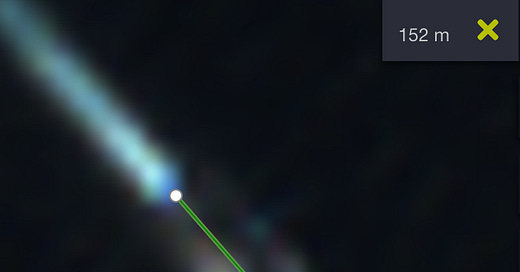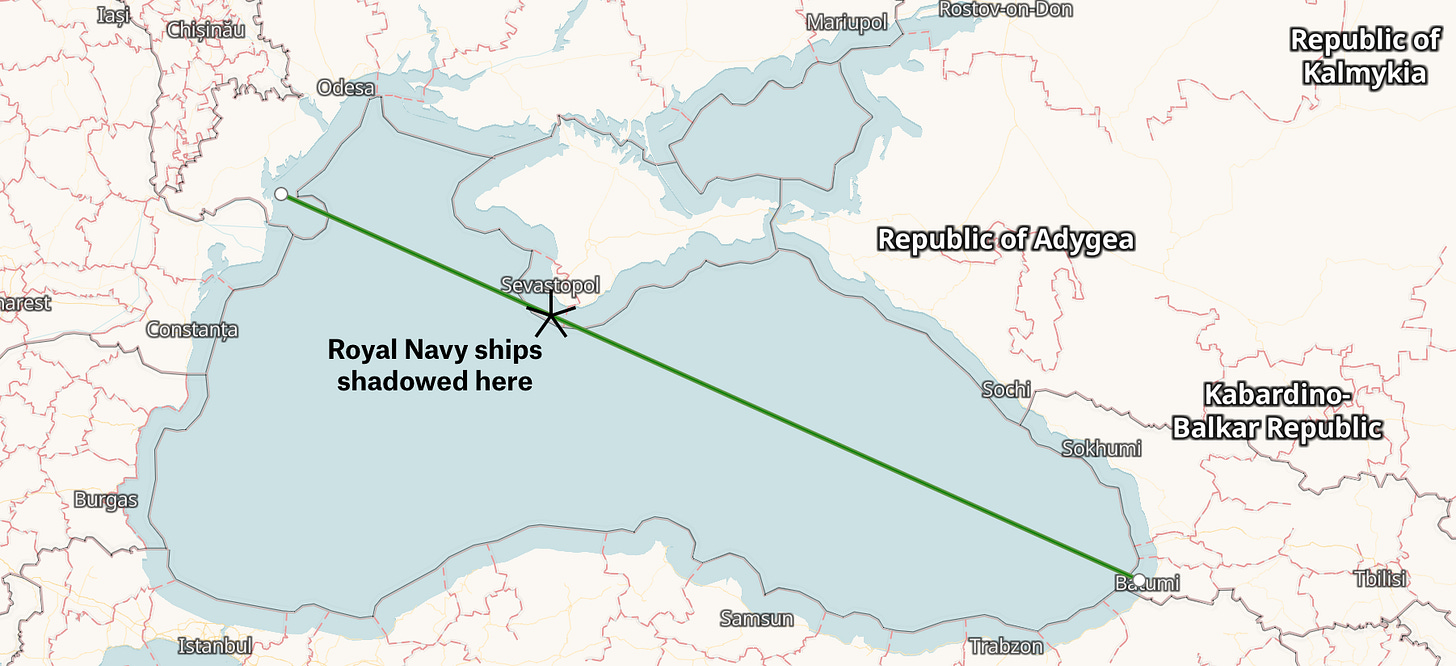Hunt for the Red October 13, 2020
Examining British and Russian claims about a naval showdown south of Crimea
In late May, a Russian official said that Russian naval vessels had “expelled” a British ship from Crimean waters on October 13, 2020. In response, the Royal Navy said the statement was “categorically untrue” and that the vessel involved, the Type 45 destroyer HMS Dragon, was simply “navigating a recognised safe route for all international shipping within Ukrainian waters”.
While the British statement wasn’t exactly wrong, satellite imagery1 tells a slightly different story.
Not only was there a second, unidentified vessel involved in the incident in addition to HMS Dragon, but the Russians responded to the UK flotilla loaded for bear. The Russian Navy sent at least two vessels after the UK’s ship: a Project 22160 large patrol boat, a smaller patrol boat, and possibly also an as-yet unidentified vessel. Three other Russian Ropucha-class landing craft were also in the area, though likely not directly responding to the UK incursion.
What’s more is that the UK vessel was well within the 12 nautical mile boundary of Crimean coastal waters. While foreign military ships are allowed to cross the territorial seas of other countries under the UN’s principle of innocent passage, there are some limitations to innocent passage (e.g. military ships conducting innocent passage can’t gather intelligence or engage in propaganda within the other country’s seas). We unfortunately don’t know enough about the activities of the British ships at the time to assess the nature of their innocent passage.
What’s not in dispute is that the UK vessel did cross an international border, even if it was sailing a well-recognized route between two ports.
But what does the imagery actually show? What can we prove is true or untrue about the British and Russian statements?
Examining the Imagery
Here’s the main flotilla involved in the incident as captured on Sentinel 2 imagery. It shows the British ship in Crimean coastal waters being shadowed by two Russian naval vessels.
Note: the Russian Project 22160 patrol boat may actually be a Project 1124 Grisha-class corvette - the resolution is too poor to tell for sure - but I think the length and profile of the Project 22160 line up better with the ship in the imagery.
Let’s zoom in on some of these ships. First up are HMS Dragon and the second ship (which both the Brits and Russians left out of their statements). I originally thought it was the Royal Navy amphibious transport dock HMS Albion but, as Devrim Yaylali correctly pointed out, HMS Albion never crossed into the Black Sea. HMS Dragon’s Twitter account confirmed that she crossed the Bosporus Strait into the Black Sea sometime around October 7, 2020 - almost a week before the Crimean incident took place (despite the implication in the tweet, she did not cross with HMS Albion or the support ship RFA Lyme Bay):





The length of the ship seen in the satellite imagery matches up with the length of HMS Dragon perfectly. According to Wikipedia, HMS Dragon (below) is 152 meters long.
But that leaves the second ship! Though it’s roughly the same length as HMS Albion, Albion wasn’t in the Black Sea at the time. It may be an accompanying Turkish or Ukrainian ship but I’ve yet to confirm that. If you have any guesses, shoot Devrim and I a message on Twitter.
While the wake for the British ship isn’t particularly clear, the wake for one of the Russian ships is just barely clear enough to count five wake waves in the space of 276 meters. Based on the formulas in my piece about how to calculate ship speeds from satellite imagery, these measurements mean the ship is sailing at about 18 knots.
A UK government document says the HMS Dragon’s cruising speed is also 18 knots. While the connection between the British ship’s listed speed and the Russian ship’s speed in the image could be completely spurious, it seems more likely that the Royal Navy vessel sailed through Crimean waters at its cruising speed of 18 knots, while the Russian ship shadowed it at the same speed.
So where does that leave us? Essentially with the HMS Dragon racing through Crimean coastal waters with at least two Russian ships and the unidentified third ship in hot pursuit.


Many thanks to @OSINT_1 for his thoughts, corroborations, and graphic!
Unfortunately, this is only a single image. As much as I’d like to know more, we just can’t tell what happened before or after the Russian ships responded to the HMS Dragon.
But why was the British Type 45 destroyer in Crimean waters in the first place?
The Twitter account of the HMS Dragon said the ship had been exercising with the Ukrainian Navy earlier in October before posting about a port visit to Batumi, Georgia later that month. Traveling from Ukrainian coastal waters to Batumi would have brought the flotilla directly through the Crimean coastal area Russia claims as its own.
Perhaps this was the UK’s version of “freedom of navigation operations” in which a military vessel will sail through a disputed area (for example, the Taiwan Strait) to show that merchant shipping can safely use that sea lane.
At any rate, while we can’t tell if Russian ships “expelled” the Royal Navy from Crimean coastal waters, it is clear from the satellite imagery that a British ship was within the 12 nautical mile Crimean sea boundary and that the Russians sent a formidable force to respond to the alleged British incursion.








